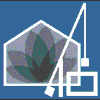GedcomMobile is a program for browsing gedcom files on ARM-based Pocket PCs and Smart Phones running Windows Mobile. It has been implemented entirely in C++ and handles even very large gedcom files with a minimum of memory consumption. It has been tested on a (relatively slow!) HTC Touch 200 mz smart phone with a gedcom file with almost 18000 individuals (about 4.5 MB). Loading the file in this case takes almost a minute, however browsing is fast.
Gedcom files must be copied "manually" to the Pocket PC. No synchronizing with the PC takes place, and it is not possible to edit the file. Also pictures and other multimedia files must be copied to the Pocket PC in case detailed data are accessed with the optional HTML viewer (see below).
The program supports all character sets defined for Gedcom 5.5: ANSI, ANSEL, UNICODE (high-low and low-high byte order, with or without BOM), four different newlines (LF,CR,CR+LF,LF+CR). The program adapts dynamically its view to the size of the screen of the Pocket PC. I.e. when shifting between landscape and portrait mode no restart is necessary.
Short Manual.
GedcomMobile has been designed to be operated with a single hand, without resorting to pen input. The buttons are large and easy to activate with the thumb. The user interface consists of four views (the examples are from royal92.ged, a gedcom file with the English Royal family which can be downloaded here):
- Current Family (fig. 1)
- Pedigree (fig. 2, appears when pressing one of the "A"-buttons in the first view)
- Descendants (fig. 3, appears when pressing the "D"-button in the first view)
- Detailed data (fig. 4, appears when pressing one of the spouses or the marriage entry in the first view)


Fig.1-2.


Fig.3-4.
The first view allows the user to browse from one generation to another: from parents to children or from parents to grandparents.
The second view allows the user to browse in larger steps back in time. A new "current family" can be selected by pressing the source person (left-most person) in the pedigree. With "+" and "-" the depth of the tree is selected (8/16/32/64 ancestors). "<" is a conventional "back-button".
In the third view the user browses in larger steps forth in time. A new "current family" is selected by pressing the uppermost family on the screen. With "+" and "-" the depth of the tree is selected (children/children and grandchildren/children, grandchildren, and great-grandchildren etc.). "<" is a conventional "back-button".
The point of departure of browsing is a certain, pre-selected start-up family. In the first view, the child leading to this start-up family is marked in a bold font. In the third view, ancestors of the start-up family occur as preselected elements. By pressing the button "Ancestral", the direct line from the current family to the start-up family is shown.Also the names' index (accessed through the menu) marks ancestors as preselected elements (fig.5). Users can search the index through simple scrolling or through keyboard input. In the latter case, the program has automatic completion (as a T9 dictionary used for SMS-messages).

Fig. 5.
A suitable start-up family can be found through the menu item "find good start-up". The program then finds the family with the largest number of ancestors and other relatives in the file. Subsequently, the found family can be chosen as the start-up family through the menu.
Data as HTML
Version 2.x supports conversion of detailed data to HTML an viewing these converted data with an optional HTML-viewer (fig. 6)

Fig. 6. (Data as HTML, as opposed to fig. 4)
The HTML-viewer is a separate program implemented in c# and requires the .NET Compact Framework v. 1 or later. Pictures etc. must be copied to the Pocket PC and their new location specified through the menu "Setup Paths".
Download v. 2.0
The program can (on the users' own responsibility) freely be used on Danish Pocket PC's (with the locale "DA", for other systems the program is available only for 6 months). Version 2.x does not support the somewhat faster internal presentation of characters in multibyte, that otherwise is sufficient for most European languages. In return, version 2.x. incorporates a number of improvements like support for HTML and especially taking a number of the peculiarities of gedcom files generated by Legacy into account.
The version for desktop-computers, called GedcomImMobile!, allows the user to access all four views simultaneously. Simulation of the version for Pocket PC/Windows Mobile can be tried out through the "setup" of the menu.
Previous versions
Version 1.1 is available in the following sub-versions:
- Multibyte - version (faster, however only support for Western European character sets)
- Widechar - version (Unicode, slower, but support for all character sets, including e.g. simplified Chinese etc.):
- Multibyte and Widechar (Unicode) - for Desktop PC:
